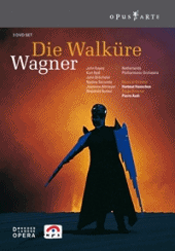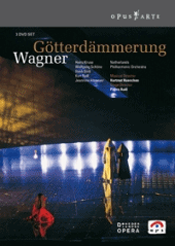13 Mar 2007
WAGNER: Die Walküre; Götterdämmerung
Two weeks before viewing these DVD’s, I attended a performance of the same opera at De Vlaamse Opera in a new production by Ivo van Hove; Flemish boss of the most important Amsterdam theatre company.

Two weeks before viewing these DVD’s, I attended a performance of the same opera at De Vlaamse Opera in a new production by Ivo van Hove; Flemish boss of the most important Amsterdam theatre company.
The Ghent Walküre was fully updated and didn’t yield in the least to familiar Wagnerian staging (with the exception of five magnificent Lippizaner horses which brought the fallen heroes to Walhalla: the sure method of getting the attention nowadays of television). Due to the literal translation of the libretto, some snickering was inevitable when the ‘Schwert’ of the surtitles turned out to be a laptop. And, yet this reviewer preferred this brilliant madness over a hotchpotch of modern clichés and old-fashioned antics as often will be found on these Amsterdam recorded DVD’s. In Walküre Mr. Audi (the Amsterdam boss who handed out this plum to his own highly esteemed self) uses a giant ramp in the form of half a ring (you get it?) with the orchestra stuck in the space between two ends. That will do for Hunding’s place, a rocky desert and Walhalla as well and it reminds me very much of the failed Carmen production at the same house where the same ramp was doing service. Nevertheless traditionalists will enjoy a few swords and spears plus Wotan’s eyepatch. Less traditionalists will be happy thanks to Brünnhilde and her sisters wearing metal (or plastic) wings and a ‘ballet’ at the start of the third act which makes for one of the most embarrassing scenes I’ve ever seen. The costumes are of an ugliness seldom rivalled and are a cross between Robin Hood and traditional Iraqi-clothing; the exception being Siegmund who looked like Papageno in a wrong opera.
In his direction of his singers Audi never rises above many worn clichés of ‘Das Regietheater’. Of course it’s not the director’s fault that Goethe’s ‘In der Beschränkheit zeigt sich der Meister (Brevity proves genius)’ didn’t appeal to Wagner. But during those often overlong monologues or dialogues, Audi too doesn’t come up with anything better than ‘drop a coat, pick it up, drop it again etc’. Sometime there is variation when the singers are busy with winding, unwinding, winding again of a long scarf between them. Yes, I know the scarf is a symbol of ….(fill in whatever you fancy). It’s all superfluous and there is no compelling idea to be found in this production. Even Wotan’s machinations and the controversy between raw power and the force of the law as represented by Fricka doesn’t stick deep. This Wotan doesn’t seem more than a hapless intriguer.
The redeeming factor therefore must come from all things musical and honours surely go to the orchestra which plays magnificently for Haenchen. The Netherlands Philharmonic Orchestra is the second Amsterdam orchestra and plays most of the productions at Het Muziektheater. Once a year the more famous Concertgebouw orchestra takes over and though the sound may be a little more brilliant it always strikes me as an orchestra on an outing while the Philharmonic’s warm sound and disciplined reading is more suited to opera. Haenchen prefers a transparent and lighter reading than usual. During these Ring performances he was the first to use the new Richard Wagner Gesamtausgabe and this results in an energetic reading, doing away with some of the slow tempi which were so loved by the German conductors of the thirties. One wonders if one reason for Haenchen’s lightness of texture doesn’t lie with the available casts. Amsterdam has a solution for the dearth of real Wagner voices. The editor of Opera Nostalgia was present at the performance and told me that the singers were blatantly miked. But even a microphone cannot hide Jeannine Altmeyer’s lack of vocal heft. She has a warm and youthful sounding voice eminently suitable for Brünnhilde but she is overstretched and flat at the top of the voice. Then main vocal disappointment of the set is John Bröcheler’s Wotan. He starts out carefully, obviously pacing his voice for a long evening. The volume at least enhances during the evening but so does the barking in the worst Bayreuth tradition. He uses some effective diminuendos but no beauty appears in the throaty sound and his lack of legato spoils the moving ‘Leb wohl, du kühnes herliches Kind’. John Keyes is an acceptable Siegmund with good rounded tones, fine in his big two arias though one has to live with his slightly beefy voice. Nadine Secunde sounds thin an wobbly on this DVD but, sadly to say, not so in the house: the case of a voice not responding well to a microphone. Reinhild Runkel is a good solid though maybe too small sounding Fricka and she doesn’t dominate her husband. So the honours must go to Kurt Rydl as Hunding who is the only one fully at ease in his role, rolling out his fine big voice with ease. And with his experience he is a most menacing villain in whatever Walküre production one is lucky to meet him.
In Götterdämmerung we meet the same Ring set though this time the designer has it almost full circle and has added an upwards rampart which can serve Siegfried coming down or anyone going up. The costumes are even more ugly and probably clumsy to wear. Siegfried with a straw hat on his back looks like Ingrid Bergman in ‘the Inn of the Sixth Happiness’. Later on the hat reveals itself to be the Tarnhelm. Gunther and Gutrune are clothed like hussars while Hagen shows his naked torso and wears trousers with suspenders. The chorus too will not have been too happy with costumes that make them look like giant Oscar figures. And the worst sin of all concerns the Rhinemaidens. Each of them looks exactly like Spiderman and it is a prime example of a director and a costume-designer conceitedly sticking to their concept when common sense tells them not to as one of the ladies is spectacularly endowed and not an example of the use of health food. Nevertheless the lady has to run and to crawl and to make lewd gestures as well. And once again as in Walküre, when singers mention the glow of fire an appropriate small electric bulb appears.
Nevertheless Pierre Audi is more inspired than in Walküre because the gloomy story and the spectacular ending appeal more to his visual sense. He makes very good use of magnificent lighting which he shrewdly, and happily often colourfully uses to illustrate the unfolding story. Audi was always obsessed by the elements and red and blue are prominent, symbolizing water and fire while green only appears very effectively once at the end to prove the birth of a new world. The Brünnhilde immolation is very impressively and yet simply done. Brünnhilde is in the midst of a giant red cloth, blown up and down by the wind machine and though this may sound unpromising the visual effect is still stunning. The lighting and the involvement of the singers therefore succeed in offering us probably the best part of the Amsterdam Ring. It is not a version one will turn too again and again but the Götterdämmerung-part at least is worth while watching. Audi didn’t tamper overmuch with the story too though not every director has Hagen killing Gutrune as well but at least the villain is punished for his crimes as Wagner prescribed.
No theatre nowadays can take its pick among the few singers who are able to stick more or less to the score. One has to take what is available. Heinz Kruse is not a bad Siegfried. He enunciates clearly and there is some metal in the voice though it seams the voice is rather small which is not unusual for one who till his 46th birthday was a . . . buffo. Still his many meetings with Mozart and operetta composers have given him a legato that at least on DVD makes him better than many a bigger voiced Siegfried. One weakness he cannot overcome is his lack of height. I’ve seldom seen a less imposing hero and he clearly has orders to avoid when possible each opportunity to stand on the same level as the other singers as he is clearly some inches shorter than his Brünnhilde while Gunther towers a full head over him. Jeannine Altmeyer is in better form than in Walküre: the voice carries better and she is a very feminine and vulnerable lady. Her final scene is impressive and the flatness noticeable in earlier evenings is happily absent. Wolfgang Schöne is a warm-voiced Gunther while Eva-Maria Bundschuh sings somewhat too shrilly. And then there is that tower of strength that is Kurt Rydl. The house comes down when he takes his bow and rightly so as the sound is rich, big and with exemplary legato. And as an actor too he peers over everybody else. Hartmut Haenchen proves once more to be a master at the helm of his orchestra. He doesn’t milk the score for effect but Siegfried’s Rheinfart is beautiful in his quick silvered handling while the funeral music has one sit up and marvel once again at Wagner’s inspiration and orchestration. Haenchen gives his singers time to breath without hurrying them and the report between pit and scene is excellent. There seems to have been no incidents and if there were, the editing was done professionally. Synchronization between mouth position and sound is perfect and the picture quality is excellent.
Jan Neckers
 |  |